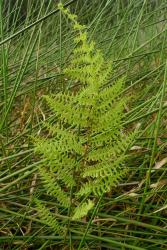Terrestrial ferns. Rhizomes short- to long-creeping, scaly. Rhizome scales ovate, entire. Fronds monomorphic or slightly dimorphic. Stipes scaly. Laminae 1-pinnate-pinnatifid, herbaceous to coriaceous, the proximal pinnae not or little reduced in size; basal pinnae not conspicuously auricled acroscopically; aerophores absent; abaxial surface of laminae bearing flat thin scales, erect acicular hairs and short-stalked glands, but lacking sessile spherical glands. Veins free, sometimes forked in the pinnules and reaching the margins. Sori round, indusiate; paraphyses absent. Indusia reniform, bearing short-stalked glands. Sporangia bearing short-stalked glands near annulus, but lacking hairs on the stalk. Spores monolete, irregularly and minutely spinulose.
Allan (1961) included all indigenous New Zealand species of Thelypteridaceae within a broadly construed Thelypteris. Holttum (1971) redefined the genus globally to include just two species characterised by a long-creeping rhizome, unreduced basal pinnae, free veins that are often forked in the pinnules and reach the margins, scales on the lower surface of the costae, acicular hairs and short-stalked glands on the lower surface of the lamina, no sessile glands, indusiate sori, and sporangia that bear short-stalked glands. Holttum’s concept remained unchanged following the classification of Fawcett & Smith (2021).
A genus of two species with one in temperate Europe and Asia and the other in tropical and subtropical regions of the southern hemisphere in South America, Africa, India, Malesia and Australasia (Fawcett & Smith 2021). One species in New Zealand; none endemic.
| Category | Number |
|---|---|
| Indigenous (Non-endemic) | 1 |
| Total | 1 |
The base chromosome number in Thelypteris is x = 35 (Holttum 1971; Smith 1990; Fawcett & Smith 2021).




